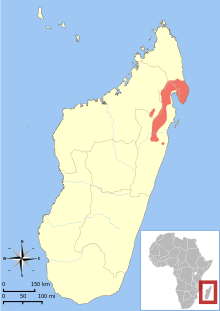Masoala fork-marked lemur
| Masoala fork-marked lemur | |
|---|---|
.png) | |
| Scientific classification | |
| Kingdom: | Animalia |
| Phylum: | Chordata |
| Clade: | Synapsida |
| Class: | Mammalia |
| Order: | Primates |
| Family: | Cheirogaleidae |
| Genus: | Phaner |
| Species: | P. furcifer |
| Binomial name | |
| Phaner furcifer de Blainville, 1839[3] | |
 | |
| Masoala fork-marked lemur range[1] | |
The Masoala fork-marked lemur (Phaner furcifer), also known as the eastern fork-marked lemur or Masoala fork-crowned lemur, is found in the coastal forests of northern and western Madagascar.
Phaner furcifer subsists on a diet consisting mainly of the gum of trees in temperate deciduous forests. It has become specialized for harvesting this substance. Like most lemuriform primates, it has a toothcomb, which is used to scrape the gum that oozes from insect holes in a tree's surface. This structure consists of a row of lower teeth that are long and forward pointing.[4]
The female experiences estrus for only three to four days of the entire year, typically in June. She gives birth to a single offspring in November or December. The offspring initially lives in the tree hole of the parents, then is carried by the mother, first ventrally, then dorsally.[4]
References
| Wikispecies has information related to: Eastern Fork-marked Lemur |
- 1 2 Andriaholinirina, N.; et al. (2014). "Phaner furcifer". IUCN Red List of Threatened Species. Version 2014.1. International Union for Conservation of Nature. Retrieved 2014-06-15.
- ↑ "Checklist of CITES Species". CITES. UNEP-WCMC. Retrieved 18 March 2015.
- ↑ Groves, C.P. (2005). Wilson, D.E.; Reeder, D.M., eds. Mammal Species of the World: A Taxonomic and Geographic Reference (3rd ed.). Baltimore: Johns Hopkins University Press. p. 114. OCLC 62265494. ISBN 0-801-88221-4.
- 1 2 Nowak, R. (1999). Walker's Mammals of the World (6th ed.). Baltimore and London: The Johns Hopkins University Press.
